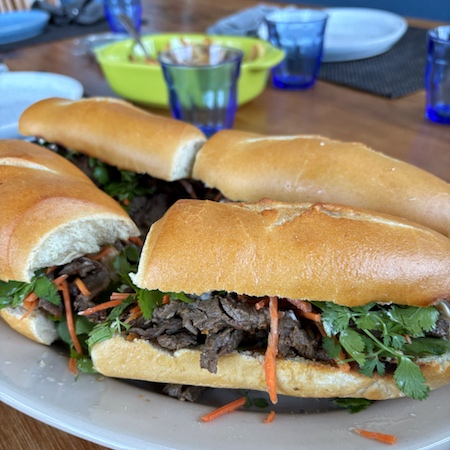Quick, convenient and healthy. That’s the way I like things to be when I’m in the kitchen. And, when it comes to satisfying those requirements, I turn to my wok. This basic tool of Chinese cookery that is found in more and more American kitchens these days, wasn’t immediately popular when it first became widely available in the U.S. This was simply because it’s design was not conducive to use on American stoves, which had flat surface burners set relatively close together. It wasn’t until Joyce Chen invented the original flat-bottomed, stir-fry pan in the late 1960s, that the wok became a popular piece of cookware throughout the U.S. In addition to flattening the bottom of the pan to enable it to work on Western stovetops, the pan was smaller and included a long handle, making it more convenient for Western cooks. Today, nearly every cookware manufacturer includes this stir-fry pan (often called the Peking Pan) in their product mix.
The process of stir-frying involves cooking small pieces of meat and vegetables quickly, over a high heat. For this reason, a good quality wok should be made of highly conductive material. A traditional wok is made of carbon steel, but today’s versions come in many different materials, including cast iron, stainless, copper and aluminum. Manufacturers have added nonstick coatings to woks, and have even introduced versions complete with a plug. However, purchasing an electric wok is often advised against because it is an expensive alternative to a pan that is extremely efficient and can be cost effective in its traditional form.
“An electric wok, in my estimation, is nearly useless for real stir-frying,” says Barbara Tropp in her cookbook The Modern Art of Chinese Cooking; Techniques and Recipes (William Morrow).
(FYI – This book is a treasure trove of information – great reading for technique, traditions and, of course, recipes.)
Today’s stir-fry pans are designed to be used to cook ingredients over high heat. It’s high sloping sides create a hot spot at the bottom of the wok, where the cooking takes place. The sides are utilized to rest the food already cooked, or ingredients waiting to be cooked. By moving the food around the pan, you gain much control over the cooking process.
A 14-inch wok is the size Tropp recommends. To many, this may seem too big, but as she points out even though the 14-inch wok may encroach on neighboring burners, “a smaller wok limits the amount and type of the thing you can stir-fry with ease.”
We have electric burners at our home, and have found that a flat-bottomed wok works best in ensuring food is in contact with the heat. For those with flame burners, the traditional round-bottomed woks work best, and a wok ring will help keep them stable on the burner.
Cooking in a wok is easy to master, but does require a bit of organization (i.e. precutting the food), and timing. Tropp says, “stir-frying is primarily a matter of using one’s senses – hearing, sight, smell, touch and taste – and that is the tuning into and exploitation of these senses that makes for successful stir-frying.”
The tools required for stir-frying are few, simple and easily acquired. A Chinese spatula is a long-handled utensil that has a wide, flared, and rounded metal edge that conforms to the shape of the wok. It is used for stirring and tossing the food, although a wooden spoon may be used if you don’t have a Chinese spatula.
The wok is extremely versatile way to quickly cook foods and when used in combination with a bamboo steamer, you can add to its usability. If you like to deep fry, a tempura rack makes this quite easy.
All in all, it is relatively easy and inexpensive to get started stir-frying. Once you get the hang of it, the wok may turn out to be one of your favorite, and most-used pieces of cookware in the kitchen.
This week we’ve included a delicious stir-fry recipe from Cuisinart in our Weekly Menu.


